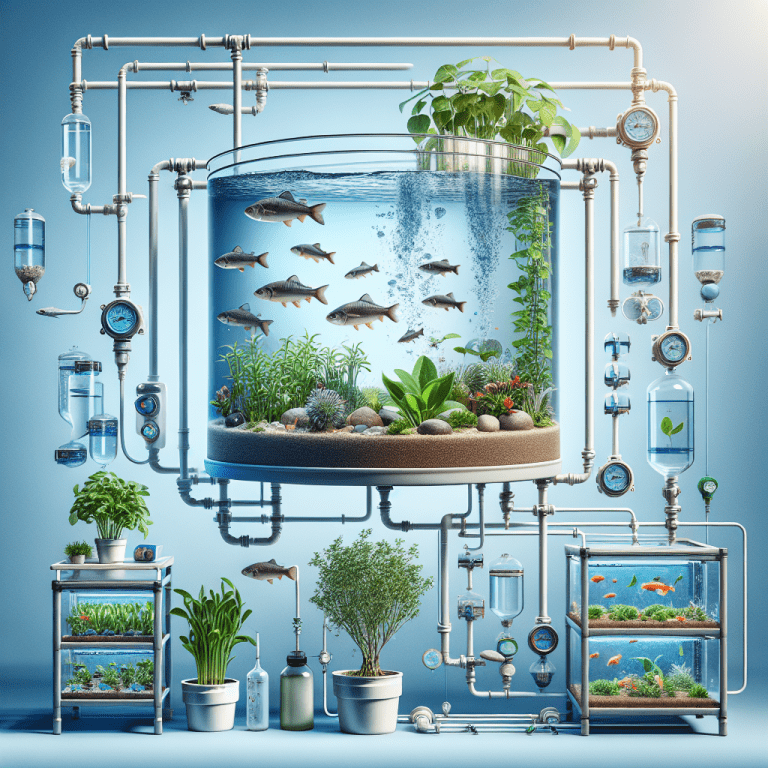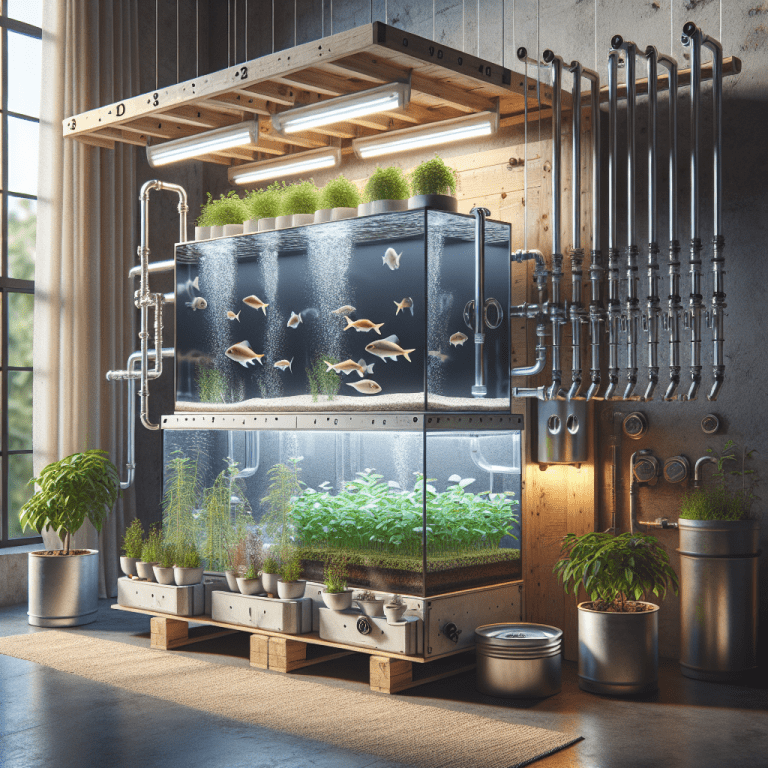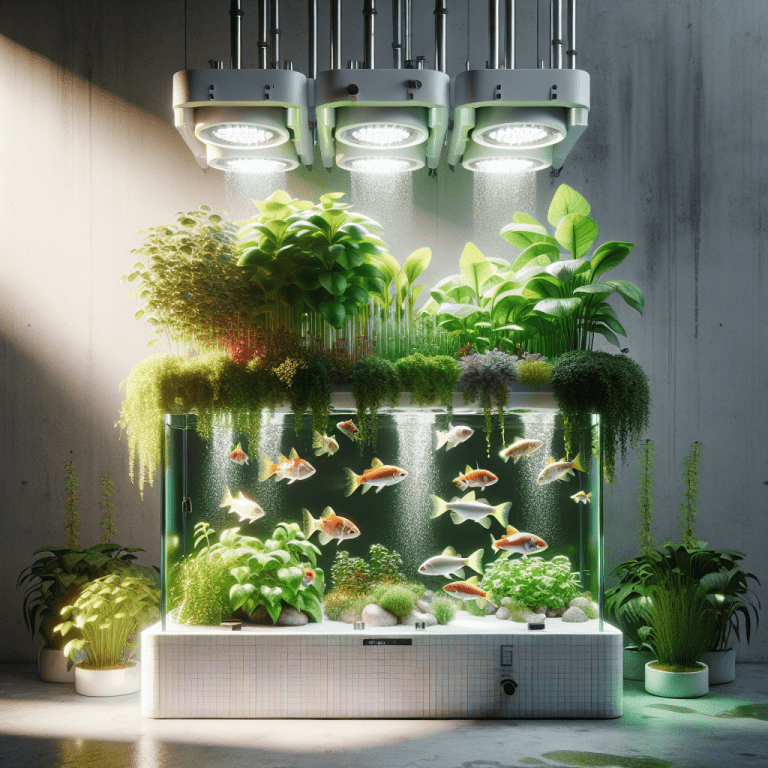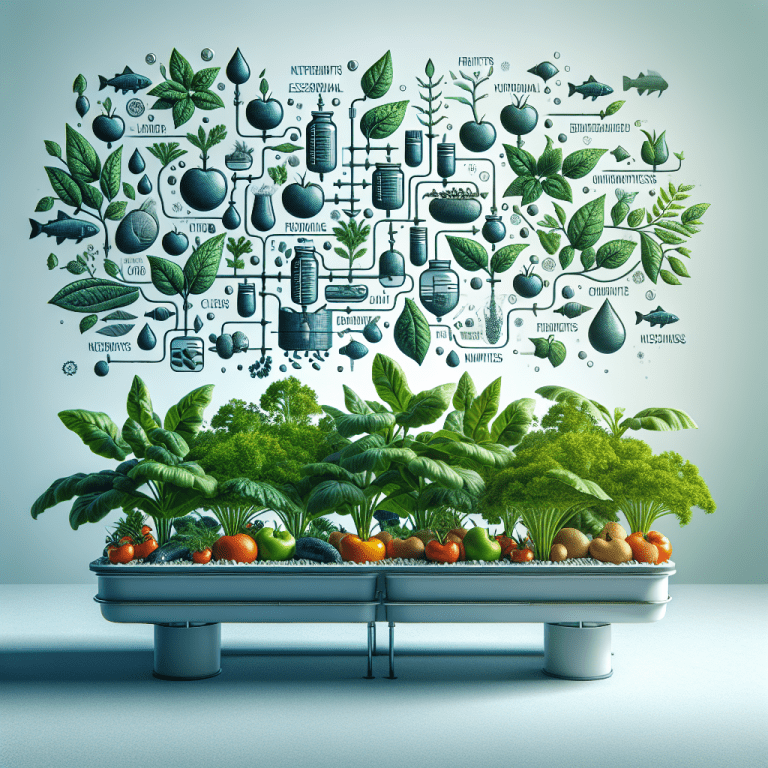Welcome to the vibrant world of aquaponics! Ever wondered how you can grow your garden, minus the soil? Fascinated but maybe a tad overwhelmed? We get it. Starting an aquaponic garden setup can feel like learning an alien language. But don't sweat it – we have your back.
Our aim? To answer your questions, uproot your uncertainties, and guide you on your exciting journey into the realm of water gardening. We're here to help you choose the perfect location, pick the right fish, setup your system, maintain water quality, grow your plants, and even overcome common glitches—all while keeping it light, straightforward and, above yes, fun!
So, ready to dive in and unravel the mystery of aquaponics? In your hands, lies the power to cultivate lush veggies and herbs, teeming with life, without even getting your hands dirty. Bonus: as a lover of all things natural, you'll contribute to a healthier planet.
You'll soon see, embarking on an aquaponic adventure is easier than you'd ever imagined. Buckle up and join us as we navigate together through this step-by-step guide to aquaponics—infusing you with knowledge and confidence required to bring your green dreams to life. Brace yourself, your aquaponic journey begins now!
Understanding Aquaponic Garden Setup
So, you’re intrigued by the idea of creating your own aquaponic garden setup? Imagine, fresh and crispy lettuce within arms' reach, growing harmoniously alongside colorful, swimming fish! Sounds neat, huh? Just not sure how to start? Luckily, you're not alone. Mastering the ABC's of an aquaponics setup isn’t rocket science. It's a journey of innovation and creativity. Let's get started!
You’ll begin with a fish tank, the 'heart' of the aquaponic system. This is where your fish will live comfortably and, incidentally, produce waste. Yuck, I know! But bear with me. Microbes, those unsung heroes of the natural world, transform this waste into nourishing nutrients for plants.
That's all happening underwater, but what about the plants? They need an 'island', of sorts, where they can grow while their roots dangle into the water. We call this the grow bed. It's filled with clay pebbles or similar media that help filter the water and assist the microbes in their nutrient conversion process.
Round and round it goes in an environmental ballet! Fish feeding plants and plants cleaning water for fish. This kind of cycle is what makes an aquaponic garden setup exceptional and, dare I say, magical! It’s a perfect example of nurturing interdependence – a vivid lesson you can apply in daily life, too.
Who would have thought that your desire for fresh produce could also introduce an exciting new hobby and a wonderful way to give back to nature? By creating an aquaponic system, you are, in your own unique way, maintaining the delicate balance of our ecosystem. This kind of endeavor epitomizes the concept of health and wellness, extending it from personal well-being to a broader, community-conscious level. So roll up your sleeves and dive in!
Selecting the Right Location for Your Aquaponic System
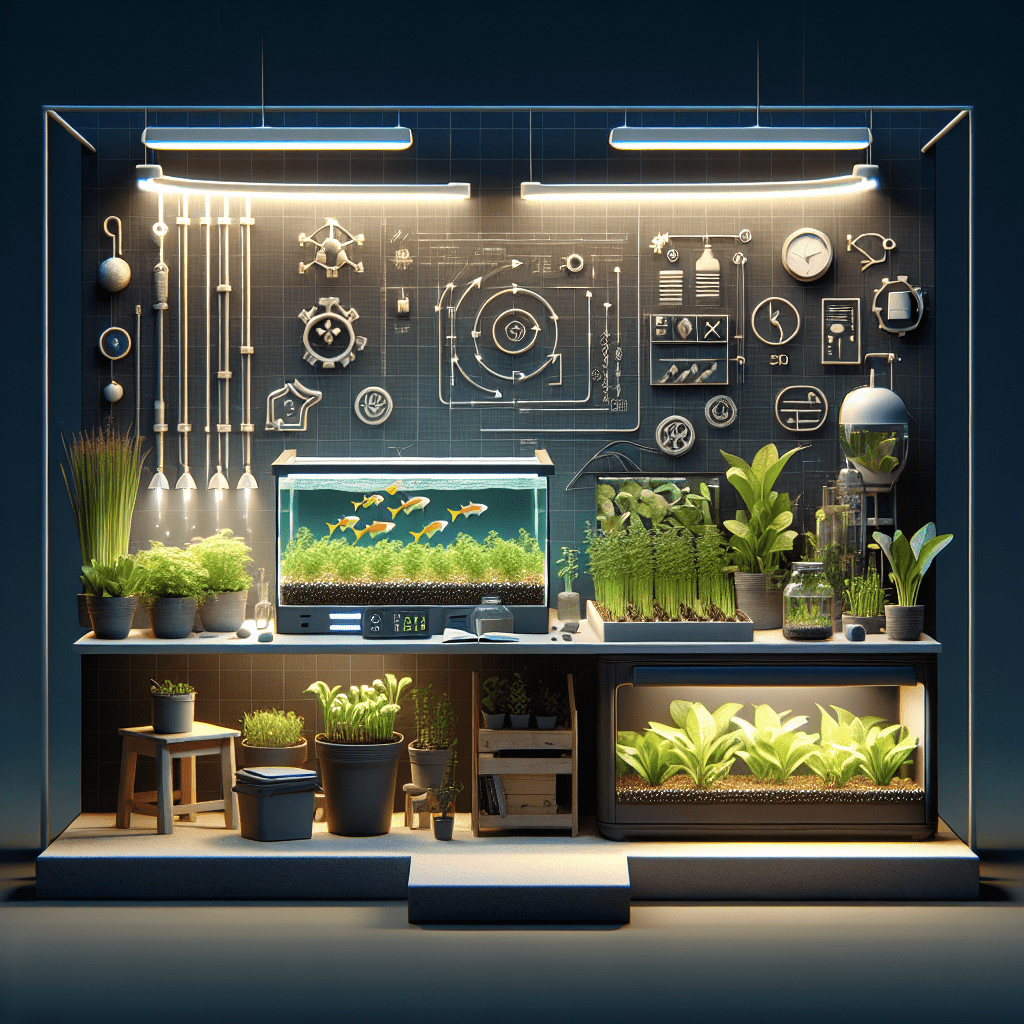
Choosing the perfect spot for your aquaponic garden setup presents a challenge. But don't worry, we got you covered! Like buying that trendy indoor plant you've been lusting over, this decision could play a massive role in your journey towards a healthier lifestyle. So let's dive in!
Sunshine is your best friend here. Good old Sol provides essential light for your plants. Avoid extreme shade; we're going for sunny vibes all around! Indoor setups require windows with bright sunlight or specific grow lights.
Temperature is the next factor on our hit list. Cold is a no-no folks. A room that consistently stays between 70 and 86 degrees Fahrenheit is your sweet spot. It allows fish and plants to thrive together in an ecosystem, creating a stunning aquaponic garden setup.
Don't forget about moisture levels! House plants love it, but your aquaponic setup could introduce too much. Aim for a well-ventilated spot, away from record collections or sensitive electronics.
Lastly, you'll need easy access to water and power sources. Picture it like setting up a home office; except instead of charging laptops and phones, we're powering pumps and filtering systems.
Every unique space calls for a tailored strategy. But armed with these fundamentals, you're well on your way to enjoying your own blooming aquaponic garden! And guess what? You'll be crafting this garden of wellness with just the right dash of innovation and creativity. Feeling motivated yet?
Choosing the Best Fish for Your Aquaponic Garden
“Moving forward in our journey, let's dive deeper into our aquaponic garden setup! We've discussed selecting the right location and choosing equipment. Now it's time for an exciting part – adding fish into the equation.
When starting out, opt for hardy species that can handle changing conditions since imbalance risks occur as systems settle. Goldfish, for instance, are survivors, great swimmers, and, let's be honest, they’re kind of cute.
Consider tilapia too. They're practically the poster child of aquaponics. Why? Apart from being tasty, they adapt well to changes. They also grow fast, speeding up your garden's productivity.
However, choosing fish isn't just about survival or growth rate. Consider your local climate too. Cold place? Try trout. Live somewhere hot? Go for catfish. Your aquaponic garden setup can thrive if you match the fish variety to your growing environment.
Also, remember that each fish has unique needs. Some prefer bright lighting while others enjoy darker surroundings. Some love crowded tanks. Others, not so much. So, if your chosen fish looks more uncomfortable than a cat in water, research and adjust the conditions accordingly.
This tail…I mean tale, of fish selection shows the beauty of aquaponics — it's a playful, creative process. Just keep swimming, and you'll be an expert soon!”
Setting Up the Aquaponic System Components
Moving forward in our journey to a healthier living, let's dive into what it takes to successfully set up your first aquaponic garden system. Don't let the technicalities scare you; we've made it as simple as setting up your new smartphone.
First, get a fish tank. It doesn't have to be a huge one. Think of it like choosing a pot for a houseplant. Size accordingly with your space and patience level. Fill the tank with water, situate your pump, and let the water flow. This mimics a mini river, soothing and visually appealing.
Next, introduce fish into their new home. Picture this, your own aquatic pets, thriving and contributing to your ecstasy. They'll bring the ocean to your backyard. Plus, they produce the nutrients needed for the plants. It's a symbiotic relationship, just like wine and cheese.
Top the system with a grow bed filled with small clay pebbles or a similar medium. These act as the soil would in a traditional garden. Here, use seedlings of your favorite herbs or veggies. Watching your edible greens sprouting brings a sense of accomplishment.
Lastly, balance your aquaponic garden setup. Adjust the water and fish-plant ratio. It's like making a music playlist; it needs harmony and balance. Add in some patience, perseverance, and a dash of creativity, and voila! Your piece of edible, underwater Eden is ready.
Setting up an aquaponic garden can be straightforward, exciting, and rewarding. Embrace the trailblazing spirit in your wellness journey. This is a significant step towards innovation and creativity. Let's get our hands a little wet and dig into sustainability, shall we?
Maintaining Water Quality in Your Aquaponic Garden
Fantastic, you've assembled your aquaponic garden setup. Pat yourself on the back. But now, you ask, how do I ensure my miniature green world's water remains pristine as a mountain spring? Spoiler: It's not as tricky as you might fear.
First up, remember the fish feed your plants while plants filter the fish's water. This symbiotic relationship sustains an efficient water cycle in your aquaponic garden setup. However, it's only one slice of the water-quality pie.
Add a pH monitor. This will help keep your neat little water world's balance in check. Think of it as the careful hiker that avoids leaning too much to one side. Go for a pH value around 7, the magic neutral point. If your water teeters too high or too low, just introduce additives to nudge it back.
What about temperature, you ask? Fish, just like us in a wintery night or a sunny beach day, enjoy certain temperature ranges. A neat water heater or cooler can help when temperature’s off-mark. Even the Goldilocks of fish, tilapia, don’t prefer too hot or too cold!
Water quality is crucial, yes, but remember creativity and innovation are your best friends. Test, try and tweak! An efficient aquaponic garden setup will take some trial and error, but it's more than worth it. Imagine munching on fresh salads, packed with nutrients you nurtured yourself. Pleasant thought, isn't it? You're one eco-conscious, health master! Let's make that envisioning a reality.
Planting and Growing in Your Aquaponic System
Building on insights shared earlier, let’s dive right into the heart of your aquaponic garden setup process. Now that you've got your system in place, it's time to introduce the stars of the show: the plants. But hold on! Just like a blockbuster movie can’t be created overnight, a successful aquaponic garden setup also needs time and patience.
The planting process doesn't have to be intimidating, though. A good starting point is seedlings, nurturing them in rockwool cubes or loose coco coir. They're a surefire way to see success. Remember to be gentle when planting. Imagine you're handling a newborn bird. Too rough, and the bird – or in this case, the plant – may not survive.
What's more, do consider sustainable production. You can regrow many vegetables from scraps – like green onions or lettuce heads. Innovative, cost-effective, and environmentally friendly!
Then comes the growth phase. An aquaponic garden setup might seem challenging at first. Maintaining the correct pH levels, monitoring fish health, and taking good care of the plants might seem like a big juggling act. But don't worry. You got this! After all, didn't you manage to master your mom's famous triple-layer chocolate cake?
In our health-focused society, this is our chance to control what goes into our bodies. So, let's stay innovative and creative. Next week we tackle nuances of maintaining your system. Remember: every pro was first a rookie.
Troubleshooting Common Issues in Aquaponic Garden Setup
While exploring the fascinating world of an aquaponic garden setup, it's only natural to face a few bumps along the road. This is no reason for despair, though. The aquaponic garden setup is a dynamic space and provides excellent room for learning, innovating, and creativity. Let's dive right into common issues and explore ways to overcome them.
Consider this. Overnight, you start noticing all your beautiful lettuce's leaves going yellow. Don't panic, it’s likely a sign of nutrient deficiency, perhaps a lack of iron. Simple fixes include adding an iron chelate – it's like giving your garden a healthy shot of multivitamins. It’s all about adapting and maintaining – like updating your phone apps for smoother functionality.
Then there's the fear of fish not eating. Initially, this might put you in a tizzy, but remember, just like we sometimes skip meals when we're stressed, fish too can lose appetite due to sudden changes, like temperature fluctuations. Monitoring and preserving optimum conditions mimics the sense of calm we feel in a spa, ultimately benefiting the plants.
What if you spot a slow drainage? Picture a busy rush hour traffic scene – that's your plant roots potentially clogging the system. Regularly trimming the roots helps maintain smooth flow, just as timely use of traffic lights manages congestion.
Navigating your aquaponic garden setup journey can taste like trying to flip pancakes for the first time. You might get the odd burnt one, but with patience, practice, and the spirited drive of an explorer, you’re sure to dish out fluffy, golden pancakes in no time! Or in our case, a thriving, healthy aquaponic garden.
Wrapping up our journey, you've now dived into the innovative world of aquaponic garden setups. You've learned about locations, fish species, and complex system components. Heck, you even know about maintaining water quality. In telling this story, we've taken complexity and stripped it down to basics.
Remember feeling overwhelmed and unsure? Look how far you've come. This guide was your map through unfamiliar terrain, and now you're on the other side. Imagining the lush, grid-like beauty of your future garden? Feels motivating, doesn't it?
Imagine juicy tomatoes, crisp lettuce, and hearty kale right from your own home. Also, healthy fish swim in a serene, self-sustained ecosystem. Setting it all up may have felt arduous but look what you've achieved.
Sure, obstacles might pop up now and then. But hey, so does life! Face it with creativity. If the fish aren't happy, check the water's pH. Plants looking pale? Likely an iron deficiency. Intimidated? Smile back at the challenge! You now have tools to tackle obstacles with confidence.
Alright, time to bring our chat to an end. However, don't mistake it for a goodbye. This might be the wrap of the guide, but it's the start of your aquaponic garden journey. Embrace this opportunity. Make your mark on this innovative path today! Cheers to green fingers and exciting beginnings.
